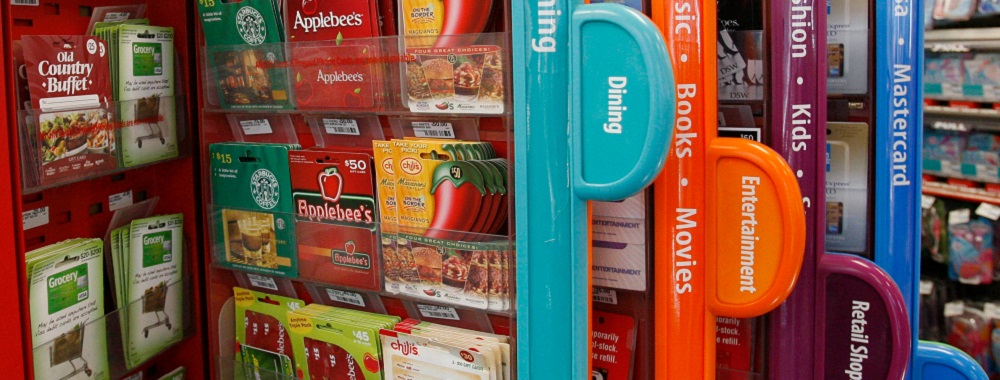On a recent Christmas shopping excursion, I noticed an influx of kiosks positioned in the front of every store from Walgreens to Walmart. They seem to rise from the floor like UFOs, populating almost every square inch of prime retail space. At first glance, it made me think of Japan with its ever plentiful array of unique displays and insatiable appeal. However, these (displays) are now the new NEW and can be found in almost every retail establishment imaginable. They are omnipresent, unavoidable and here to stay. Also, retailers that house these kiosks usually receive a small percentage of commission for selling the cards – hence their added incentive for selling even the cards of major or minor direct competitors.
Gift cards, while not new, have seen a meteoric rise in their popularity since the 1990s. The National Retail Federation predicts that 81% of shoppers will purchase at least one gift card this year and will spend an average of $156.86 – notably, the highest amount in the ten-year history of the survey. Total spending for gift cards will approach a staggering $30 billion. Is this why these seemingly innocuous pieces of branded plastic have gained such enormous popularity? I suspect that it is, and here are a few reasons why:
- Ease of use and safety: Gift cards are the perfect remedy for the holiday shopping blues, thus providing an easy alternative to endless hours searching for that perfect gift. They have the unique ability of allowing receivers to pick a product that truly suits their tastes versus receiving the polka-dot tie or cologne they could do without and pretending to love it. Global online retailers like Ebay and Amazon are the home base for exercising gift cards and have even opened the door for the creation of secondary industries, with companies like GiftRocket, creating online alternatives to the gift card.
- Ability to purchase: Gift cards are available across a multitude of channels and are totally ubiquitous. They can be purchased in every big box retailer, online or through mobile apps, as Starbucks has shown us. The cross-channel, user-friendly experience offers the consumer more ownership, as it pertains to tackling the long “To-Do” list during the holiday season.
- Cost to acquire consumers: The cost to acquire a new consumer for businesses has risen precipitously, largely due to increasing inflation and just plain competition. Gift card providers now allow companies, big and small, to exercise a covert branding campaign by quietly letting their logo, colors and brand equity do the talking.
- The CARD Act: Congress passed a landmark piece of gift card legislation, entitled the CARD act, prohibiting closed-loop cards from expiring in under 5 years. While the law covers credit card accountability, it also establishes consumer protection for gift certificates, store gift cards, and general-use prepaid cards through amendments to the Electronic Fund Transfer Act (EFTA). Specifically, Section 401 of the Credit CARD Act requires fee and expiration date disclosures for gift certificates, store gift cards, or general-use prepaid cards; limits dormancy, inactivity, and service fees for these cards and certificates; and establishes a minimum period of five years before the underlying funds for these cards and certificates can expire.
That being said, gift cards will be a fixture in the big box ecosystem for the foreseeable future. So, when you go shopping this season, ask yourself who has been naughty and nice, and what card you will graciously reward them with.
